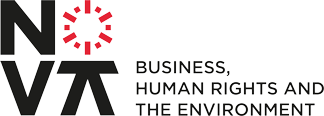About the author: Alison E. Holm is a PhD Candidate in management at Copenhagen Business School, conducting work on responsible business conduct. Alison is also an associate at Nova Centre on Business, Human Rights and the Environment and will be joining the Nova School of Business and Economics as an Assistant Professor in the ERA Chair in Social Innovation in September 2022. In her research, she strives to understand the ways by which cross-sector interactions between corporations and civil society lead to constructive solutions for addressing crucial social and environmental challenges, including human rights. In her dissertation, she studies complaints filed under the grievance mechanism of the OECD Guidelines for Multinational Enterprises. Before her dissertation, she gained expertise on the OECD Guidelines through her experience as a policy analyst at the OECD where she reported on the role and activities of National Contact Points.
The OECD Guidelines for Multinational Enterprises (Guidelines) are a set of recommendations for multinational firms on how to conduct responsible business. The Guidelines’ unique grievance mechanism permits any party with an interest in the matter to submit a complaint to a National Contact Point (NCP) alleging that a corporation has not followed the Guidelines. NCPs who accept complaints for examination typically offer a platform for dialogue between complainants and corporations.
The extent to which this mechanism is effective in providing remedy to victims has been of great concern, particularly to members of civil society. In June 2021, the non-governmental organization OECD Watch shared its view that the “expectations [the Guidelines] give to the NCP complaint mechanism are too low, leading to an ineffective, unpredictable system for remediating corporate impacts” [1].
As part of this important discussion, my co-author Jasper Hotho (Copenhagen Business School) and I wanted to learn more about the results of the NCP mechanism on the ground. More specifically, rather than focusing solely on the ability for NCPs to provide remedy, in our working paper [2], we were intrigued by the more open and explorative question: what are the different outcomes of NCP dialogues on human rights? Answering this question permits a comprehensive understanding of the results of the NCP mechanism and enables to set realistic expectations on its capacities, not only for providing remedy but also for addressing corporate misconduct more generally.
Understanding outcomes of NCP dialogue on human rights issues
When complainants and corporations find an agreement through the NCP mechanism, they usually include some form of corporate commitment to changing behavior or policy. While they do not ensure corporate behavioral change, corporate commitments are a necessary first step towards action. In addition, the public nature of corporate commitments permits to hold firms accountable for their implementation or lack thereof.
To uncover the corporate commitments coming out of NCP dialogues, we studied all complaints filed under the Guidelines between 2000 and 2018 that alleged human rights breaches [3] and were accepted by NCPs for examination. To do so, I first built a database with key information on all 425 complaints that were submitted between 2000 and 2018. I then identified 34 complaints on human rights that resulted in a corporate commitment. These complaints cover a range of sectors (from hydropower to pension funds) and countries of harm. Most complaints (27) were submitted by non-governmental organizations, five complaints were submitted by trade unions, one was submitted by a lawyer and one was submitted by an individual. Complaints were submitted to the NCPs of Australia, Austria, Brazil, Canada, Denmark, France, Germany, the Netherlands, Norway, Switzerland, the United Kingdom and the United States.
Jasper and I inductively analyzed the outcomes of these dialogues, in three rounds of coding based on 152 documents. In total, we found 35 different types of corporate commitments that we classified into 7 broader types of non-mutually exclusive commitments.
Corporate commitments as an outcome of NCP dialogue on issues of human rights
1. Acknowledging responsibility vis-à-vis the issue
As a result of fourteen complaints, companies acknowledged general responsibility vis-à-vis the issue through acknowledging responsibility to identify, prevent and mitigate harm. This type of outcome does not constitute a commitment per se. Rather, it shows a general, symbolic understanding of expectations, which can serve as a preliminary step towards commitment to change. For an example of this result, after allegations of human rights violations in Qatar, FIFA reportedly “accept[ed] its responsibility to mitigate risks” (NCP of Switzerland, 2017).
Acknowledgment of present and future responsibility towards an issue often included a reference to international standards, such as the Guidelines, which communicate an understanding of (general) expectations.
2. Pursuing dialogue with stakeholders
Corporate commitments to pursuing their dialogue or further engage with stakeholders constitutes an interesting outcome present in twenty-one cases.
In some cases, corporations committed to improving existing dialogue with stakeholders or starting new engagements with stakeholders involved or represented in complaints. For instance, CERMAQ, a Norwegian company who allegedly failed in considering indigenous peoples’ rights in Canada and Chile, explained that it “will seek to enter into mutually beneficial agreements with indigenous people” (NCP of Norway, 2011).
Importantly, corporate commitments also include promises to facilitate connections between different parties. For instance, after the Austrian company Andritz faced allegations of contributing to the adverse impacts of the Xayaburi Dam in Lao, the company committed to: “discuss[ing] the situation of the resettled communities and to support the remaining complainants in their respective efforts by helping them to establish direct contact to the Xayaburi hydropower project developer […] and/or the government of Lao PDR, if necessary” (NCP of Austria, 2017).
3. Adopting organizational policies and practices to prevent issues raised in the complaint
In twenty cases, companies committed to adapting their organizational policies and/or practices with the objective to prevent future issues. For instance, Andritz committed to “develop policies and procedures in relation to the implementation of human rights and environmental standards” (NCP of Austria, 2017).
4. Advocating with internal and external stakeholders
A particularly interesting outcome featured in fifteen cases is the commitment to hold an advocacy role on the issue. Corporations in these cases promised to advocate the issue to the government of the country of alleged harm (5 cases) but also to convey best practices to corporate partners (13 cases). The Swiss company Louis Dreyfus Commodities Suisse S.A., accused of “contributing to the systematic and extensive use of child labor” in Uzbekistan committed to “continu to engage with the Uzbekistan authorities and other stakeholders in order to address the Issue” (NCP of Switzerland, 2012).
5. Assessing the impact of its activities on the issue
At the outset of eleven complaints, companies committed to conducting impact assessments more actively. Such commitments either addressed a specific demand in the complaint to assess impact, or emerged from more general requests. One example relates to the complaint accusing Arla Foods of having failed to examine possible adverse human rights impacts in their milk powder sales in Côte d’Ivoire. After the Danish NCP accepted the complaint against Arla, parties independently reached an agreement in which Arla committed to “[test piloting] its due diligence procedures by conducting and publicizing human rights impact assessments” (Joint statement by ActionAid Denmark and Arla Foods, 2014).
6. Repairing or ceasing harm
In five cases, we found that corporations committed to repairing (or remediating) the alleged harm. After the Canadian company Kinross was accused of damaging local homes in Brazil through the use of explosives, “Kinross confirmed its intent to repair the homes” (NCP of Brazil, 2016).
Companies in four cases also committed to ceasing activities that allegedly caused harm (see for example, the case of SOCO International).
7. Learning more about the issue raised in the complaint
In two cases, corporations committed to learning more about the issue raised in the complaint. For instance, after the complaint against GSL, a firm that provides immigration detention services, the company stated: “GSL agreed to seek input from human rights experts to deliver human rights training as appropriate” (NCP of Australia, 2006).
Towards leveraging a variety of outcomes
The NCP mechanism faces great criticism regarding its ability to provide remedy to victims of corporate harm (see for example OECD Watch’s Remedy Remains Rare, 2015). Our investigation confirms that NCP dialogue does not systematically result in corporate commitments to remedy.
To understand the capacity of the NCP mechanism to address corporate misconduct, it seems important to acknowledge its historically limited record for providing remedy while admitting the broader diversity of outcomes that the NCP mechanism have offered. Specifically, our results show that NCP dialogue has helped sensitize companies to stakeholder expectations and get them to commit to actions that help prevent future harm. Based on this information, the NCP mechanism already has general, albeit “soft”, capacity to make companies commit to better following international standards on human rights. This capacity could be leveraged more systematically towards more companies by facilitating access and procedures for complainants. In addition, NCPs could offer services outside of complaints to companies to help them proactively improve their policies and behaviors.
Two additional areas of work could help strengthen the NCP mechanism. First, the variation in NCP quality does not ensure a reliable dialogue with the best chances to lead to corporate commitments. It appears essential to improve the quality of lagging NCPs. Second, corporate commitments are of course limited in that they are symbolic and do not guarantee action. Investing in NCP follow-up assessments is essential to ensure that corporate commitments are followed by concrete corporate measures. While certain NCPs do engage in such practice, much work remains to be done for ensuring systematic quality follow-up by NCPs.
Footnotes:
[1] OECDWatch, 2021, “Get Fit: Closing gaps in the OECD Guidelines to make them fit for purpose”.
[2] Contact the author for more information.
[3] The Human Rights chapter was introduced in the OECD Guidelines in 2011. We manually coded complaints filed before the 2011 reform to identify their relevance to the chapter on Human Rights.
This blog symposium is organised in the framework of the Postdoctoral Project “Improving the effectiveness of non-judicial remedies for business-related human rights abuses” led by Dr. Laura Íñigo Álvarez and funded by the Fundação para a Ciência e a Tecnologia (FCT) – FCT Reference UIDP/00714/2020.
Suggested citation: A. Holm ‘Understanding the effectiveness of OECD National Contact Points: uncovering corporate commitments as outcomes of NCP dialogue on human rights issues’, Nova Centre on Business, Human Rights and the Environment Blog, 3rd January 2022.
Latest Posts
Categories
- Annual Conference on Business; Human Rights and Sustainability
- Blogging on B&HR: Towards an EU CSDDD
- Business and Human Rights Developments at the European Level
- Business and Human Rights Developments in Central and Eastern Europe
- Business and Human Rights Developments in Southern Europe
- Business and Human Rights in Conflict
- Business and Human Rights in the World
- Corporate Sustainability Due Diligence Directive
- Exploring new frontiers in the updated OECD Guidelines
- Latest Business and Human Rights Developments
- National Contact Points for Responsible Business Conduct: the road ahead for achieving effective remedies
- Notícias sobre Empresas e Direitos Humanos
- Second Annual Conference on Business; Human Rights and Sustainability
- Serie de blogs “Explorando los caminos hacia el acceso efectivo a la justicia en materia de empresas y derechos humanos”
- Short-Termism in Business Law: A Global Approach
- Sustainability Talks
- Young Voices and Fresh Perspectives

